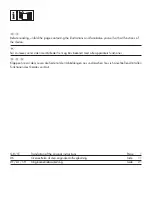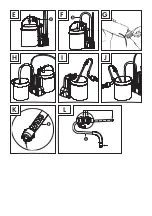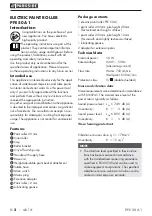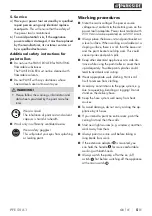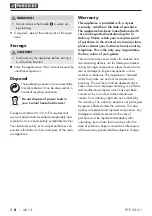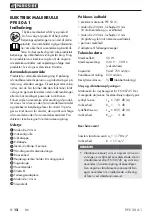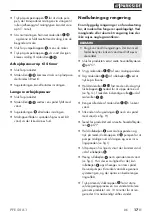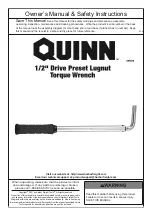
PFE 50 A1
GB
│
IE
│
3
■
WARNING!
►
The vibration level varies in accordance with
the use of the power tool and may be higher
than the value specified in these instructions
in some cases. Regularly using the power
tool in such a way may cause you to under-
estimate the vibration load. Try to keep the
vibration loads as low as possible. Measures
to reduce the vibration load include, e.g.
wearing gloves and limiting the working
time. Wherein all states of operation must be
included (e.g. times when the power tool is
switched off and times where the power tool
is switched on but running without load).
General power tool
safety warnings
WARNING!
►
Read all safety warnings and instructions.
Failure to follow the warnings and instructions
may result in electric shock, fire and/or serious
injury.
Save all warnings and instructions for future
reference.
The term "power tool" in the warnings refers to your
mains-operated (corded) power tool or battery-
operated (cordless) power tool.
1. Work area safety
a)
Keep your work area clean and well lit.
Cluttered or dark areas invite accidents.
b)
Do not operate power tools in explosive
atmospheres, such as in the presence of
flammable liquids, gases or dust.
Power tools
create sparks which may ignite the dust or
fumes.
c)
Keep children and bystanders away while
operating a power tool.
Distractions can cause
you to lose control.
2. Electrical safety
a)
Power tool plugs must match the outlet.
Never modify the plug in any way.
Do not use any adapter plugs with earthed
(grounded) power tools.
Unmodified plugs
and matching outlets will reduce risk of electric
shock.
b)
Avoid body contact with earthed or grounded
surfaces, such as pipes, radiators, ranges and
refrigerators.
There is an increased risk of elec-
tric shock if your body is earthed or grounded.
c)
Do not expose power tools to rain or wet
conditions.
Water entering a power tool will
increase the risk of electric shock.
d)
Do not abuse the cord. Never use the cord for
carrying, pulling or unplugging the power
tool. Keep cord away from heat, oil, sharp
edges or moving parts.
Damaged or entangled
cords increase the risk of electric shock.
e)
When operating a power tool outdoors, use
an extension cord suitable for outdoor use.
Use of a cord suitable for outdoor use reduces
the risk of electric shock.
f)
If operating a power tool in a damp location
is unavoidable, use a residual current device
(RCD) protected supply.
Use of an RCD
reduces the risk of electric shock.


